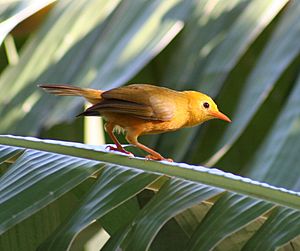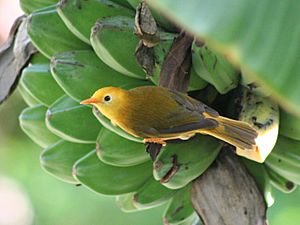Golden white-eye facts for kids
Quick facts for kids Golden white-eye |
|
|---|---|
 |
|
| Conservation status | |
| Scientific classification | |
| Genus: |
Cleptornis
|
| Species: |
marchei
|
| Synonyms | |
|
Ptilotis marchei |
|
The golden white-eye (Cleptornis marchei) is a beautiful yellow bird that belongs to the white-eye family, called Zosteropidae. It's the only species in its special group, or genus, called Cleptornis.
This bird was once thought to be a type of honeyeater. But now, scientists know it's a white-eye, even though its exact spot in the white-eye family is still a bit of a mystery. The golden white-eye lives only on the islands of Saipan and Aguijan in the Northern Mariana Islands. Here, it shares its home and sometimes competes with another bird, the bridled white-eye.
The golden white-eye is easy to spot with its bright golden feathers and a light ring around its eye. It eats insects, fruit, and sweet nectar from flowers. These birds often search for food in pairs or small family groups. They stay with one partner for life and lay two eggs in a small cup-shaped nest.
Long ago, golden white-eyes also lived on Tinian and Rota. But they disappeared from those islands because of human activities. Even though there are many golden white-eyes on Saipan and Aguijan today, they are still considered an Endangered animal. This is because of a big threat: the invasive brown tree snake. This snake has caused a lot of problems on nearby Guam, and if it reaches Saipan, it could quickly harm the golden white-eye population. People are working hard to control these snakes and to breed golden white-eyes in zoos to help protect them.
Contents
What's in a Name?
This bird used to be called the golden honeyeater because people thought it was a type of honeyeater. A French scientist named Émile Oustalet first described the bird in 1889. He placed it in a group called Ptilotis, which isn't used anymore. Later, it was moved to the group Cleptornis, which Oustalet had set aside just in case this bird was unique.
In 1987, an American bird expert, Harold Douglas Pratt, Jr., noticed that the golden white-eye acted and looked like other white-eyes. Later studies agreed with him. It might be related to the Micronesian white-eyes or the Bonin white-eye, another species that was once thought to be a honeyeater.
The name Cleptornis comes from old Greek words meaning "robber" and "bird." This name isn't about how the bird acts. Instead, it refers to the old French name for the Mariana Islands, which was "Robbers' Islands." The second part of its scientific name, marchei, honors a French explorer and writer named Antoine-Alfred Marche, who collected the first samples of this bird.
Where Do They Live?
The golden white-eye lives only in the Northern Mariana Islands in the western Pacific Ocean. This means it is endemic to these islands. You can find them on Saipan and Aguijan.
These birds live in many different places, both natural and man-made. They are common in native forests, especially those on limestone. But they also live in open areas with bushes and even in towns and cities. On Saipan, the only places you won't find them are in the wet marshes around Lake Susupe and in grassy savannas.
What Do They Look Like?
The golden white-eye is different from other white-eyes because it has large eyes and a full-sized outermost wing feather. Other white-eyes usually have a smaller or missing feather there. This is a fairly large white-eye, about 14 cm (5.5 in) long and weighing around 20 g (0.7 oz).
This bird has very bright and unique feathers:
- Its head is orange-yellow with a pale ring around its eye.
- Its back, wings, and tail are yellow-green.
- Its belly is golden orange.
- Its beak and legs are also orange.
Males and females look very similar. You can only tell them apart by measuring their wings, as males have slightly longer wings. Young golden white-eyes look similar to adults but have duller feathers. They might have brownish spots on their face and neck, and brown-yellow stripes on their chest. Young birds also have dark beaks and duller legs.
Golden white-eyes make many different sounds. Their song is a long, rough warble that sounds like "séé mé-can you séé mé-I can séé yóú-can you séé mé." They also make shorter, rough calls and whistles when they are flying or in groups. Baby birds make sad whistles when they want food from their parents.
How Do They Behave?
Like other white-eyes, the golden white-eye is active during the day. Unlike the bridled white-eye, which forages in groups and doesn't protect its area, the golden white-eye lives in pairs or small family groups. These groups usually include a breeding pair and their young birds.
Golden white-eyes are also very territorial. Pairs will sing throughout the day to respond to other pairs nearby. Groups can become aggressive when they meet each other. The golden white-eye is also aggressive towards the smaller bridled white-eye, chasing it away from food and resting spots. They will even fly through groups of bridled white-eyes to make them scatter. While they chase other small forest birds, they are less aggressive towards them. In fact, the rufous fantail sometimes follows the golden white-eye to catch insects that the white-eye stirs up.
The golden white-eye is stronger than the bridled white-eyes and rufous fantails. But it is weaker than the Micronesian myzomela, which sometimes chases it. Fantails might also chase the golden white-eye if it gets too close to their nests.
What Do They Eat?
The golden white-eye eats many different things, including fruit, berries, and insects. They also drink nectar from flowers. Along with the Micronesian myzomela and the bridled white-eye, the golden white-eye helps pollinate some trees, though it's not as important as the other species.
They catch insects by picking them off tree bark and leaves, or by catching them in the air. They prefer certain types of trees for finding food. The common forest tree Cynometra ramifolia is their favorite.
The golden white-eye and the bridled white-eye often look for food in the same areas. However, the golden white-eye eats a wider variety of foods. In the forest, they also divide up the feeding areas. Bridled white-eyes and Micronesian myzomelas mostly feed in the top part of the forest canopy. Golden white-eyes feed in both the canopy and the lower understory of the forest, as well as in smaller trees and bushes. They share the understory with the rufous fantail, which uses a different way to find food.
The golden white-eye is very good at finding insects in specific places, like dead leaves and branches. The bridled white-eye, on the other hand, prefers to find insects on live leaves. The golden white-eye is the most flexible bird in its diet and feeding style among the forest birds on Saipan. Scientists think this ability to adapt helps them survive typhoons, which can greatly change the forest.
Reproduction and Life Cycle
Golden white-eyes breed all year long on Saipan, where scientists have studied their nesting habits. The busiest breeding time is from March to July. These birds are monogamous, meaning they stay with one partner.
Their nests are simple cups made from casuarina needles, grasses, and vines. They usually place their nests about 2.9 m (between 1.5 and 6.5 m) off the ground in various trees like Casuarina, Guamia, Cynometra, Leucaena, and Citrus. Other birds, like Micronesian starlings and collared kingfishers, sometimes eat the eggs or chicks from these nests. The introduced green tree skink also preys on their nests.
A typical clutch has two eggs. They are about 20.3 × 15.1 mm in size and are pale bluish-green with red or brown spots, mostly at the wider end. Both parents take turns sitting on the eggs, each for about 25 minutes before the other parent takes over. This species is very protective of its nest, chasing away other birds, including bridled white-eyes, rufous fantails, and even other golden white-eyes.
It takes about two weeks for the eggs to hatch. The baby birds are altricial, meaning they are born naked and helpless. Both parents share the job of keeping the chicks warm and feeding them. They also remove faecal sacs to keep the nest clean. The chicks eat mostly insects and caterpillars. Young birds leave the nest about 10 to 14 days after hatching. After they fledge, they might stay with their parents in small groups for a while.
Why Are They Endangered?
The area where the golden white-eye lives has shrunk a lot since humans arrived in the Mariana Islands. Scientists have found fossil bones of this bird on nearby islands like Tinian and Rota. It might have even lived on Guam and other islands in the Marianas long ago.
Today, the golden white-eye is very common. A study in 1996 found that there were more golden white-eyes on Saipan than almost any other bird, with up to 2,095 birds per square kilometer (8.47 per acre). However, a 2009 study showed that the number of golden white-eyes on Saipan had gone down between 1982 and 2007. This was also true for two other bird species on Saipan, the rufous fantail and the nightingale reed warbler. All three birds eat insects, and their decline might be due to losing their habitat. Still, the golden white-eye is quite common, with an estimated 71,997 birds in the world.
Despite their numbers, the IUCN lists the golden white-eye as Endangered. This is because their population is expected to drop quickly if the brown tree snake reaches Saipan. The brown tree snake is from Australia, New Guinea, and the Solomon Islands. It was accidentally brought to Guam and wiped out all 12 native land bird species there.
The snake has not yet reached Saipan, which is one of the two islands where the golden white-eye lives and holds the largest population. The island of Aguijan is isolated, making it unlikely for the brown tree snake to get there. However, the small population on Aguijan is at risk because the island is only 718 ha (1774 acres) in size. A direct hit by a very strong typhoon could wipe them out.
People are working to protect these birds. They are trying to breed the golden white-eye in zoos and prevent the snakes from getting to Saipan. Six zoos received these birds, and breeding started in 2009 at the North Carolina Zoo. Birds bred in captivity will be released on new islands. In 2011, 24 birds were also moved from Saipan to Sarigan, an island reserve with no predators, hoping to start a new breeding group there.
Images for kids
See also
 In Spanish: Anteojitos dorado para niños
In Spanish: Anteojitos dorado para niños





